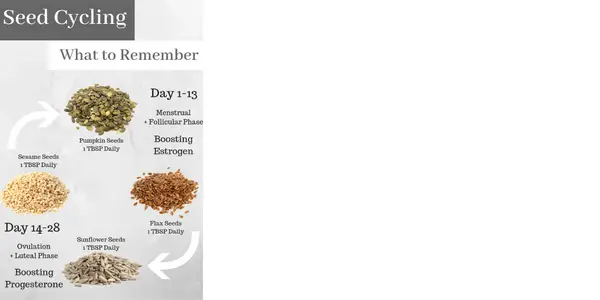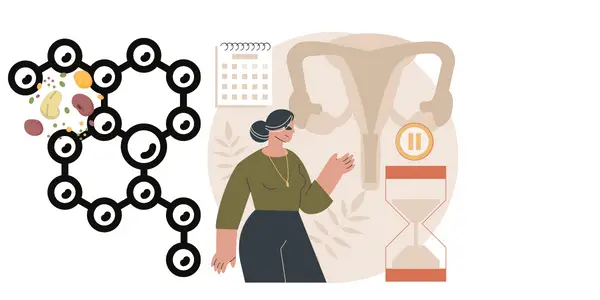Seed Cycling For Hormone Balance, Fertility & Recipes
Hey there! Have you heard of seed cycling chart? It’s a natural approach to balancing hormones that’s been gaining popularity lately. The idea is to eat specific seeds at different times during your menstrual cycle to support your body’s hormone production.
It’s a simple and affordable way to potentially improve symptoms of PMS and menstrual irregularities. So, let’s dive in and learn more about seed cycling!
Seed Cycle Chart
Here is the seed cycle chart help you how to do it:-

source Pinterest
What is Seed Cycling
Seed cycling for period is a trendy way to balance hormones naturally. It involves eating a variety of seeds at specific times during your menstrual cycle to support your body’s hormone production.
The seeds cycling supplements are flax, pumpkin, black or white sesame seeds for seed cycling, and sunflower seeds. During the first half of your cycle (days 1-14), you consume flax and pumpkin seeds to support estrogen production.
During the second half of your cycle (days 15-28), you switch to sesame and sunflower seeds to support progesterone production. Some people swear by seed cycling for improving symptoms of PMS and menstrual irregularities.
How To Seed Cycling?
Seed cycling calendar works by using the nutrients found in specific seeds to support your body’s hormone production.
The main seeds used are flax, pumpkin, sesame, and sunflower seeds. These seeds are beneficial for hormone balance due to their unique nutritional profiles.
Flax and pumpkin seeds are high in lignans and essential fatty acids, and can help support estrogen production in the first half of your cycle.
Sesame and sunflower seeds are high in zinc and vitamin E, it can help support progesterone production during the second half of your cycle.
To incorporating these seeds into your diet at specific times, You can potentially support the natural ebb and flow of your hormones throughout your menstrual cycle.
While more research is needed to fully understand the effectiveness of seed cycling, many people have reported positive results and find it to be a simple and natural way to support their overall health.
Know All About Seed Cycling With The moon & Menstrual Cycle Moon
Seed Cycle
Menstrual cycle moon chart is a practice that involves aligning seed cycling with the phases of the moon. This practice is based on the idea that the lunar cycle influences the female menstrual cycle and that syncing the two can promote hormonal balance and overall health.
Here is Seed cycling with the moon phases:
- Menstrual Phase: This phase marks the start of the menstrual cycle and lasts for 3-7 days. During this time, the lining of the uterus sheds and menstrual bleeding occurs.
- Follicular Phase: The follicular phase begins after the menstrual phase and lasts for approximately 7-10 days. During this phase, the body prepares to release an egg from the ovaries
- Ovulatory Phase: The ovulatory phase is when ovulation occurs, typically around day 14 of a 28-day menstrual cycle.
- Seed Cycling Luteal Phase: The luteal phase starts after ovulation and lasts for approximately 10-14 days. During this phase, the empty follicle from which the egg was released transforms into the corpus luteum, which produces progesterone.
How to incorporate seed cycle in your everyday routine?

Incorporating seed cycle period into your everyday routine can be simple and easy! Here are some tips:
- Prepare ahead of time: Grind your seeds at the beginning of the week and store them in an airtight container so you can easily add them to your meals throughout the week.
- Add seeds to your meals: You can sprinkle seeds onto your morning oatmeal, yogurt, smoothie, or salad. You can even mix them into your favorite baked goods.
- Try new recipes: There are plenty of recipes online that incorporate seeds, such as energy bites or seed crackers. Get creative and try new things to keep your meals interesting.
- Be consistent: To see the benefits of seed cycling, it’s important to be consistent and consume the seeds every day at the appropriate times.
Remember, everyone’s body is different, and it may take some time to notice the effects of seed cycling. Be patient and listen to your body. If you have any concerns or questions, talk to your healthcare provider.
Here is the best topic you love to read:-
How to start seed cycle for hormone balance?
Starting seed cycling for hormone balance is easy! Here are the steps:
- Choose high-quality, organic seeds: Look for fresh, organic seeds to ensure that you’re getting the most nutritional benefits.
- Determine where you are in your menstrual cycle: If you’re not sure, track your cycle for a few months to get a better understanding.
- During days 1-14 of your (seed cycling follicular phase), consume one tablespoon each of ground flax seeds and pumpkin seeds daily.
- During days 15-28 of your cycle (luteal phase), consume one tablespoon each of ground sesame seeds and sunflower seeds daily.
- You can add the seeds to smoothies, oatmeal, yogurt, salads, or any other food you like. Just make sure to grind the seeds before consuming them to help your body better absorb the nutrients.
Remember, seed cycling is not a substitute for medical treatment. Talk to your healthcare provider before starting seed cycling or any other new health regimen to ensure that it’s right for you.
How does seed cycling benefits hormone balance?
The recommended amount of seeds to take during each phase of seed cycling varies depending on the source, but here is a general guideline:
Follicular phase:
- 1 tablespoon each of ground flaxseed before ovulation and pumpkin seeds per day
Luteal phase:
- 1 tablespoon each of ground sesame seeds and sunflower seeds per day
It supports hormone balance by providing the body with specific nutrients found in certain seeds that can support the natural production of estrogen and progesterone throughout the menstrual cycle.
Is there any science supporting information about seed cycling?
While there is limited scientific research on it, some studies have shown promising results. For example, a study published in the Journal of Nutrition found that consuming flax seeds may help reduce breast cancer risk in postmenopausal women by reducing estrogen levels.
Another study published in the International Journal of Food Sciences and Nutrition found that consuming sesame seeds may help improve menstrual pain in women with dysmenorrhea.
However, more research is needed to fully understand the potential benefits of seed cycling for hormone balance. Additionally, it should not be used as a replacement for medical treatment.
Follicular phase recipes – phase one

During the follicular phase, which is the first phase of the menstrual cycle, it is recommended to consume one tablespoon each of ground flax seeds and pumpkin seeds daily.
These seeds contain nutrients such as lignans and essential fatty acids, which can help support estrogen production.
You can add the seeds to your meals or snacks, such as smoothies, yogurt, oatmeal, or salads, to easily incorporate them into your diet. Just make sure to grind the seeds before consuming them to help your body better absorb the nutrients.
Seed Cycling for the lucal phase – phase two
These Seed cycling balls are a convenient and tasty way to incorporate seed cycling into your diet. They are typically made by combining ground seeds, nut butter, sweeteners, and other ingredients, then rolling them into bite-sized balls.
Cycling balls can be customized to fit individual preferences and needs. For example, someone in the follicular phase might create seed cycling balls with flax and pumpkin seeds, while someone in the luteal phase might use sesame and sunflower seeds
In addition to providing a variety of vitamins and minerals, seed bites are also a great source of fiber and healthy fats. They can help to promote hormone balance, support digestion, and provide sustained energy throughout the day.
Seeds like pumpkin, flax, sesame, and sunflower are rich in nutrients that are important for men’s health. Including zinc, magnesium, and omega-3 fatty acids. These nutrients are essential for maintaining healthy testosterone levels, supporting prostate health, and reducing inflammation in the body.
It is recommended to follow the same protocol as for women, but without the focus on the menstrual cycle. It may involve consuming a combination of different seeds throughout the week, to maximize nutrient intake and support overall health.
While more research is needed to fully understand the benefits of seeds for men. Incorporating a variety of nutrient-dense seeds into the diet. It is generally considered to be a healthy choice for both men and women.
